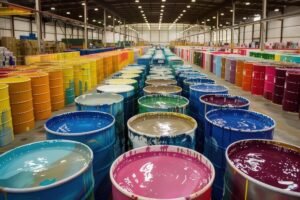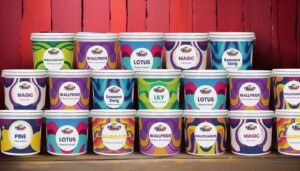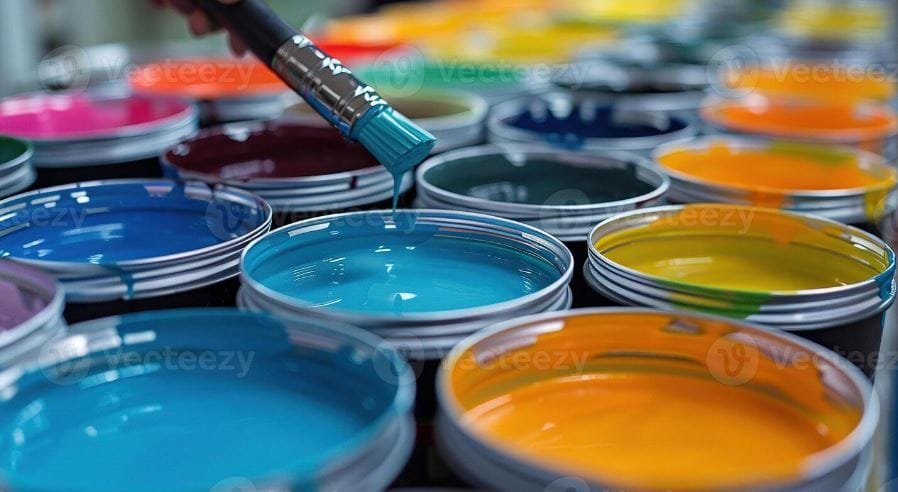Introduction to Mithila Paint Manufacturers in Udaipur
Mithila Paints is a growing brand in the Indian paint industry, known for manufacturing high-quality decorative, industrial, and protective paints tailored to the Indian market. While their primary manufacturing units are located in regions central to their operations, they are expanding their footprint across India, including Rajasthan. In Udaipur, Mithila Paints likely operates through a robust network of distributors and authorized dealers to supply their wide range of products, such as emulsions, enamels, primers, putties, and weather-resistant coatings. The company is focused on delivering innovative and cost-effective paint solutions that cater to residential, commercial, and industrial needs, ensuring durability and aesthetic appeal.
They actively encourage partnerships with local dealers in Udaipur, providing them with attractive profit margins, marketing support, and access to a diverse portfolio of products. For individuals or businesses in Udaipur looking to source Mithila Paints or explore dealership opportunities, contacting their customer service or regional sales team would be the best approach to obtaining accurate and detailed information. Their commitment to quality, affordability, and customer satisfaction makes Mithila Paints a preferred choice for many in the industry.
The work of Mithila paint manufacturers, who source these intricate paintings, plays a significant role in sustaining this tradition. Their efforts facilitate greater access to Mithila art, enabling a wider audience to appreciate and acquire these works. As the cultural relevance of Mithila painting continues to grow, it stands as a testament to India’s rich artistic heritage and the ongoing commitment to preserving these traditional practices.

The Rise of Mithila Painting in Udaipur
Mithila painting, a traditional form of art originating from the Mithila region of Bihar, has seen a remarkable rise in popularity in Udaipur over the past few decades. The resurgence of this vibrant art form can be attributed to various socio-cultural factors contributing to its acceptance and appreciation within the local community and beyond. One of the key drivers behind this growing interest is the push from local artists who have embraced Mithila painting, adapting its themes and techniques to create works that resonate with contemporary audiences.
In Udaipur, many artists have started incorporating traditional motifs and symbolism that characterize Mithila art into their work, resulting in pieces that reflect both heritage and modern sensibilities. The appeal of these paintings lies in their intricate designs, vivid colors, and the stories they convey, often depicting mythological tales, nature, and everyday life. As these local talents showcase their skills, the local demand for mithila home paints has surged, leading to a thriving market for painted products, including wall murals, home décor, and textiles.
Furthermore, the increasing appreciation for indigenous art forms has played a significant role in the elevation of Mithila painting. Art enthusiasts and collectors from various parts of India and abroad have begun to recognize the cultural significance of Mithila art, resulting in a growing market and opportunities for artists to showcase their works. This trend is complemented by various exhibitions, workshops, and cultural festivals hosted in Udaipur, which emphasize the value of traditional art while providing artists with platforms to engage with wider audiences.
As the influence of Mithila painting continues to evolve in Udaipur, its integration into home paints and interior design is evident. Homeowners and designers alike are increasingly drawn to the uniqueness of Mithila art to enhance their spaces, creating a sense of cultural identity and aesthetic appeal. Thus, the rise of Mithila painting in Udaipur signifies not only an appreciation for traditional artistry but also a modern-day revival of cultural heritage. This renaissance emphasizes the importance of indigenous crafts and their potential to thrive in contemporary settings.

Key Mithila Paint Manufacturers in Udaipur
Udaipur, known for its rich artistic heritage, is home to several prominent Mithila paint manufacturers. These establishments not only promote the traditional art form but also support the community of artists involved in this craft. One notable manufacturer is the “Mithila Arts & Crafts,” which was founded in the late 1990s. They focus on empowering local artisans by providing them with a platform to showcase their talent. Their distinctive style often incorporates contemporary themes while preserving the traditional motifs characteristic of Mithila home paints.
An established name in the Mithila paint landscape is “Shree Mithila Paints,” which has been operating for over two decades. They are renowned for their vibrant color palette and intricate detailing. The artists at Shree Mithila are skilled in various styles, including the original Madhubani forms, and they often conduct workshops aimed at educating newcomers about the techniques involved in creating Mithila home paints. Their contribution to the Mithila painting community includes collaborating with local schools to inspire the younger generation.
These manufacturers exemplify the essence of Mithila painting in Udaipur, offering unique perspectives and interpretations that enrich this vibrant art form while fostering community involvement and craftsmanship.
Techniques and Materials Used in Mithila Paint
Mithila paint, a traditional art form originating from the Mithila region of Bihar, India, embodies a rich cultural heritage and employs an array of techniques and materials. The artists often utilize natural colors derived from plants, minerals, and even cow dung, which not only emphasize sustainability but also enhance the vibrancy of the artwork. The colors are usually extracted from various sources; for instance, turmeric provides a bright yellow hue, while indigo yields deep blue shades. This reliance on organic materials not only respects the environment but also connects the art to the cultural practices of its origin.
In the traditional practices of Mithila painting, brushes play a crucial role. The artists often craft brushes from twigs of the neem tree or the end of a bamboo stick, allowing for intricate detailing. These brushes, when combined with natural colors, help create the characteristic fine lines and patterns that define Mithila artworks. The paintings are typically rendered on surfaces like handmade paper, cloth, or even walls, making the versatility of this art form evident.
While adhering to these traditional practices, many Mithila home paints manufacturers are innovating by incorporating modern techniques. For example, advancements in paint technology have led to the introduction of synthetic colors that offer greater longevity and a wider color palette without compromising the authenticity of the artwork. Additionally, the blending of traditional aesthetics with contemporary styles has made Mithila painting more accessible, appealing to a broader audience. This evolution not only preserves the heritage but also showcases the adaptability of Mithila artists in a changing market.
Ultimately, the unique techniques and materials that characterize Mithila painting reflect both its historical roots and its modern adaptations, possibly influencing the broader trends in decorative arts, including home paints aimed at celebrating cultural narratives.

The Role of Mithila Paint in Promoting Cultural Heritage
Mithila painting is not merely a decorative art form; it serves as a vibrant expression of the cultural heritage of the Mithila region in India. Traditionally practiced by women, this art form has been integral to the community’s identity, depicting various aspects of life, mythology, and spirituality. In Udaipur, Mithila home paints have gained prominence as manufacturers embrace this rich tradition, ensuring its survival while adapting it for contemporary art lovers.
Manufacturers of Mithila home paints act as custodians of this ancient art, playing a crucial role in fostering cultural heritage. They collaborate with local artisans whose skills and stories are essential to the authenticity of the paintings. By providing resources and support, these manufacturers empower artisans, ensuring that the intricate designs and techniques of Mithila painting are passed down through generations. This commitment not only helps preserve the authenticity of the craft but also enriches the cultural tapestry of Udaipur and beyond.
Cultural exchanges facilitated by manufacturers of Mithila home paints enable artists to reach broader audiences. Through exhibitions and art fairs, the essence of Mithila painting is showcased, allowing people from diverse backgrounds to appreciate this unique style. Workshops organized by manufacturers create interactive platforms where participants can learn the techniques involved in Mithila painting, further bridging the gap between tradition and modernity.
Community engagement is another vital aspect of promoting cultural heritage. These manufacturers often initiate programs aimed at fostering appreciation for Mithila art among local schools and communities. By involving the younger generation, they create awareness about the significance of this art form, which is essential for its preservation. Through these initiatives, Mithila painting continues to thrive, contributing positively to the cultural landscape of Udaipur and serving as a testament to the rich heritage of the Mithila region.
Challenges Facing Mithila Paint Manufacturers
The Mithila home paints industry in Udaipur, celebrated for its rich cultural heritage and traditional artistic techniques, encounters several significant challenges that threaten its sustainability and growth. One of the primary issues is the intense competition posed by mass-produced artwork. As consumers increasingly opt for affordability and convenience, many are turning to factory-made alternatives, which can overshadow the unique and labor-intensive creations of Mithila artists. This trend jeopardizes the livelihoods of artisans who rely on traditional craftsmanship, making it imperative for manufacturers to find innovative ways to attract consumers who value authenticity.
Moreover, the need for market expansion is paramount for Mithila paint manufacturers. While Udaipur is known for its arts and crafts, the local market alone may not be sufficient to sustain artisans and manufacturers. Many creators find themselves relegated to niche markets, limiting their customer reach. To address this, there is a pressing need for strategic marketing initiatives that resonate with broader audiences, including online platforms that promote Mithila home paints to potential buyers across different demographics.
Another challenge lies in the struggle to maintain traditional techniques within a rapidly modernizing world. As younger generations become influenced by contemporary art forms and digital designs, there is a growing risk of dilution of the distinctive styles and methods that characterize Mithila paintings. Manufacturers must strive to balance the preservation of traditional techniques while appealing to contemporary tastes, ensuring that the art form does not become obsolete.
Lastly, economic sustainability remains a critical concern for both artists and manufacturers. Many Mithila paint creators operate in precarious financial conditions, often lacking access to capital, resources, and training. To support these artisans, it is essential to foster collaborations that provide economic stability while promoting the rich cultural heritage associated with Mithila home paints.
Market Trends and Future Outlook for Mithila Paint
The market for Mithila home paints is experiencing notable evolution, driven by changing consumer preferences and an increasing demand for unique artistic expressions in home décor. Traditionally rooted in the Mithila region of India, these paintings are celebrated for their intricate patterns and vibrant colors. As interior design trends shift towards more personalized and culturally resonant choices, Mithila paints have begun to carve a niche in the broader home painting market, appealing to discerning customers who seek both authenticity and uniqueness.
One significant trend is the rise of online sales and social media platforms as promotional tools for Mithila home paints. Manufacturers are increasingly leveraging digital channels to reach a global audience, transcending geographical limitations. Social media, in particular, has emerged as a powerful medium for showcasing artistry and engaging with potential buyers. This shift not only allows for wider accessibility to Mithila art but also encourages artisans to innovate while retaining the traditional narratives that their artworks represent.
Moreover, the growing interest in sustainable and ethically produced goods is reinforcing the appeal of Mithila paints. Consumers today are more inclined to support brands that uphold ethical practices and promote cultural heritage. Paint manufacturers have the opportunity to highlight the craftsmanship involved in creating Mithila paints, providing transparency about the sourcing of materials and the artisans’ communities. This can enhance brand loyalty and consumer trust, essential components in an increasingly competitive market.
Looking ahead, it is crucial for Mithila paint manufacturers to adapt to these evolving dynamics while preserving the art’s integrity. By embracing technology and modern marketing strategies, they can foster a deeper appreciation for this exquisite art form and ensure its relevance in contemporary home décor. The future of Mithila home paints lies in balancing tradition with innovation, offering consumers not just a product, but a story that enriches their living spaces.

Collaboration with Local Artists and Communities
Mithila art, known for its vibrant colors and intricate designs, has seen a significant resurgence in Udaipur, primarily due to the initiatives taken by Mithila home paints manufacturers to foster collaboration with local artists and communities. These partnerships aim to promote not only the traditional craft but also enhance the appreciation of it within the local and global communities.
One notable collaboration involves workshops where established Mithila artists work alongside emerging talents. Such initiatives serve dual purposes: they allow for the transfer of traditional techniques and knowledge while simultaneously offering a platform for new artists to showcase their work. These workshops have become a staple in Udaipur’s cultural calendar and have reinforced the importance of community in the preservation and proliferation of Mithila art. Not only does this approach support local artisans, but it also emphasizes the value of collaboration, resulting in unique Mithila home paints that tell a story of shared heritage and creativity.
Additionally, Mithila paint manufacturers have undertaken various co-creation projects aimed at stimulating local economies and sustaining traditional craftsmanship. By sourcing materials and skilled labor locally, these manufacturers contribute to the community’s economic well-being. The designs conceived in these joint efforts often draw inspiration from local narratives and landscapes, creating a fusion that resonates with both traditional and contemporary art enthusiasts. Through these creative initiatives, Mithila home paints not only enhance interior spaces but also serve as a vehicle for storytelling, connecting dwellers to the rich cultural tapestry of Udaipur.
Overall, the collaboration between Mithila paint manufacturers and local artists represents a dynamic and symbiotic relationship that enriches the cultural fabric of Udaipur while promoting the timeless beauty of Mithila art. This influence encapsulates the essence of community-driven art, thus ensuring that this cherished tradition continues to thrive in a modern context.
Conclusion: The Continuing Legacy of Mithila Painting
Mithila painting, an intricate and vibrant art form originating from the Mithila region in Bihar, has found a unique presence in Udaipur, Rajasthan. This traditional artistry not only enriches the cultural landscape of the region but also carries with it deep-rooted historical significance. The engaging motifs, vibrant colors, and elaborate designs of Mithila home paints serve to reflect narrations from nature, mythology, and daily life, making each piece a storytelling canvas that resonates with viewers. The accessibility to these decorative art forms has increased, thanks to the concerted efforts of local manufacturers who play a pivotal role in preserving this heritage.
As we explored the dynamics of Mithila painting in Udaipur, it became evident that the manufacturers are essential in maintaining the relevance and visibility of this ancient craft. Their commitment to authenticity and quality not only nurtures traditional methods but also empowers a new generation of artists. By producing Mithila home paints that are both traditional and contemporary, these manufacturers bridge the gap between longstanding techniques and modern preferences, ensuring that the art form continues to thrive.
Supporting traditional arts such as Mithila painting is crucial for sustainability. It not only provides livelihoods for artists and manufacturers but also fosters a greater appreciation for cultural heritage among wider audiences. Individuals can contribute to the preservation of this rich tradition by purchasing Mithila home paints, participating in workshops, and advocating for the local art community. In turn, these efforts help to secure a legacy that will inspire future generations and reinforce the unique identity of Udaipur as a hub for artistic expression. Thus, the journey of Mithila painting in Udaipur is not just a story of art but a testament to cultural resilience that merits ongoing support and engagement.

